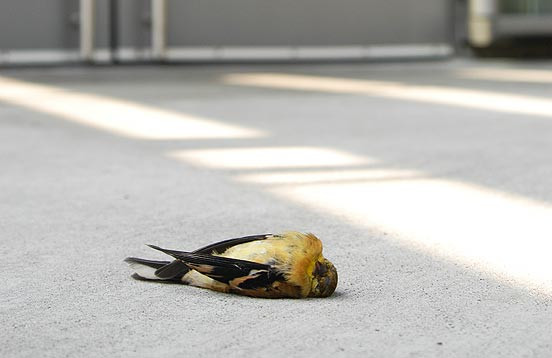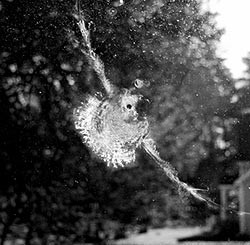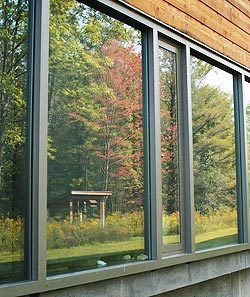Bird strikes are a heartbreakingly common event, with up to one billion birds dying each year in the U.S. from colliding with windows. These aren’t just random accidents; they represent a major threat to bird populations. Windows, often reflecting inviting scenes of foliage and sky, or appearing as clear fly-through zones, become invisible barriers for birds. If you’re asking “How Do I Stop Birds From Flying Into My Windows?”, you’re in the right place. Fortunately, there are numerous effective and humane methods you can use to dramatically decrease or even prevent these collisions at your home. From easy DIY fixes to more comprehensive approaches, this guide will provide you with the best strategies to make your windows bird-safe and protect these vulnerable creatures.
The Alarming Reality of Bird-Window Collisions
Window collisions are a leading cause of bird mortality, particularly in urban and suburban environments. Despite often flying away after a strike, many birds succumb to their injuries later due to internal bleeding, brain trauma, or other unseen damage. As researcher Daniel Klem, who has studied this issue extensively, notes, windows are “an indiscriminate killer,” affecting healthy and less fit birds alike. The sheer number of windows in our landscapes amplifies the problem, creating a widespread and continuous danger for birds navigating their surroundings.
 American Goldfinch killed by window strike
American Goldfinch killed by window strike
A deceased American Goldfinch, a victim of a window strike. Window collisions are a significant threat to bird populations, often resulting in fatal injuries even if the bird initially flies away.
Understanding Why Birds Fly Into Windows
Birds collide with windows for a few key reasons, broadly categorized into daytime and nighttime collisions.
Daytime Collisions: During the day, the primary culprit is reflection. Windows mirror the surrounding environment, especially vegetation, trees, and the sky, creating an illusion of open habitat. Birds, unable to perceive glass as a solid barrier, fly towards these reflected images, believing them to be real pathways or extensions of their natural environment. They may also see through windows to indoor plants or vegetation on the other side, further reinforcing the illusion of a safe passage.
Nighttime Collisions: At night, especially during migration seasons, artificial lights pose a significant threat. Nocturnal migratory birds, which include most songbirds, are disoriented by bright lights in urban areas. These lights can draw birds off their migratory routes, particularly in foggy or low-ceiling conditions. Confused and attracted to the light, they may circle within illuminated areas, colliding with brightly lit buildings and windows. Furthermore, birds attracted by nighttime lights may find themselves in hazardous urban environments at dawn, increasing their risk of daytime window collisions.
Territorial Aggression: Less frequently, birds may fly into windows due to territorial behavior. Especially during spring breeding season, birds may see their reflection in a window and mistake it for a rival. They may repeatedly attack their reflection, pecking and flying into the glass. While this behavior can be disruptive for homeowners, it’s generally less dangerous to the bird compared to collisions caused by misinterpreting reflections of habitat. However, the preventative measures recommended for general window strikes will also deter this territorial behavior.
 Imprint of dove on plate glass window
Imprint of dove on plate glass window
Window imprint left by a Mourning Dove after a collision. This ghostly outline is a stark reminder of the force and impact of bird-window strikes, highlighting the invisible danger windows pose.
Effective Strategies to Bird-Proof Your Windows
The key to preventing bird-window collisions is to make windows visible to birds. Birds need to perceive windows as solid objects, not as open space or habitat. Here are several effective methods you can use:
Treatments for Existing Windows: Making Glass Visible
These solutions are designed for windows already installed in your home and focus on applying treatments to the exterior glass surface.
- Paint or Soap: A simple and cost-effective method is to use tempera paint or soap to create patterns on the outside of your windows. A grid pattern with spacing of approximately 2×2 inches is recommended to deter even small birds. You can also get creative and paint decorative designs.
- Window Decals and Stickers: Applying decals, stickers, sun catchers, mylar strips, or even masking tape to the exterior of your windows can be effective if spaced correctly. For small birds, ensure spacing is no more than 2 inches apart. Hawk silhouettes alone are generally ineffective. Coverage is key; sparsely placed stickers on a large window will not prevent collisions.
- Dot Patterns and Window Tape: Specialized window tapes and dot pattern products offer a more durable and aesthetically consistent solution. Products like Feather Friendly tape are designed with pre-spaced patterns to ensure effective bird deterrence and easy application.
- Acopian BirdSavers (Zen Curtains): These consist of cords hanging vertically down the outside of windows, spaced 4 inches apart. They are highly effective, aesthetically pleasing (often referred to as “zen curtains”), and easier to install than some other methods. The Cornell Lab of Ornithology headquarters uses Acopian BirdSavers to protect its windows. You can purchase pre-made BirdSavers or create your own.
- Window Screens: Installing mosquito screens over your windows is a highly effective solution, provided they are mounted on the outside and cover the entire window surface.
- Netting: Covering windows with netting on the exterior is another very effective method. The netting should be taut and held at least 3 inches away from the glass to prevent birds from hitting the window directly. Small mesh netting (around 5/8″ or 1.6 cm) is ideal to ensure birds bounce off safely without entanglement. Netting can be attached to frames for easy installation and removal.
- One-Way Transparent Film: Products like Collidescape are films applied to the exterior of windows that allow people inside to see out but make the window appear opaque to birds on the outside. These films can also help reduce sunlight and cooling costs.
 Reflection of foliage in window – hazard to birds
Reflection of foliage in window – hazard to birds
Reflected trees and sky in a window. These reflections create the illusion of open space, deceiving birds and leading to dangerous window collisions. Identifying these reflective windows is the first step in making them bird-safe.
Solutions for New Homes and Remodeling Projects
If you are building a new home or replacing windows, consider these preventative measures during the design and installation phase:
- External Shutters: Install external shutters and keep them closed when rooms are unoccupied or when natural light and views are not desired. Shutters also offer excellent energy-saving benefits.
- External Sun Shades or Awnings: Install awnings or sun shades over windows to reduce reflections. Remote-controlled options provide convenience.
- Angled Glass: Tilting windows downwards can significantly reduce sky and vegetation reflections.
- Bird-Friendly Glass: Consider using specialized bird-friendly glass that incorporates patterns visible to birds but less noticeable to humans.
- Window Placement and Interior Design: Avoid creating visual corridors where birds might perceive a clear path through your house to outdoor vegetation or sky visible through opposing windows. Interior blinds, closed doors, or strategic furniture placement can break up these visual pathways.
Lights Out Initiatives: Reducing Nighttime Hazards
Participating in “Lights Out” initiatives is crucial, especially in urban areas. Turning off non-essential lights in buildings at night, particularly during migration seasons, significantly reduces hazards for nocturnal migratory birds. Downward-facing outdoor lighting also minimizes light pollution and its impact on birds. Even with Lights Out programs, daytime window collision prevention remains important for homeowners.
What to Do If You Find a Bird That Has Hit a Window
If you find a bird that has collided with a window, immediate action can increase its chances of survival. Even if a bird appears stunned but flies away, it may have internal injuries. Here’s how to help:
- Carefully Capture the Bird: Approach the bird gently from behind and use both hands to cup it. Hold it securely but gently, avoiding squeezing its body.
- Contain the Bird: Place the bird in a safe container, such as an unwaxed paper bag or a small cardboard box lined with tissue or paper towel. Ensure the container is closed and place it in a dark, quiet, and warm location away from pets and children.
- Do Not Offer Food or Water: Avoid handling, feeding, or watering the bird. Minimize stress as much as possible.
- Contact a Wildlife Rehabilitator: Locate a licensed wildlife rehabilitator in your area (you can find directories online, such as through The Humane Society). Contact them for guidance and instructions. They may be able to provide further care or advise on release.
- Release Instructions: If the rehabilitator advises release, take the bird to a safe, wooded area away from buildings. Before releasing, observe if the bird can fly strongly. If its flight seems weak, recapture it and contact the rehabilitator again.
By taking these steps to prevent bird-window collisions and knowing how to help injured birds, you can make a significant positive impact on bird conservation in your community.